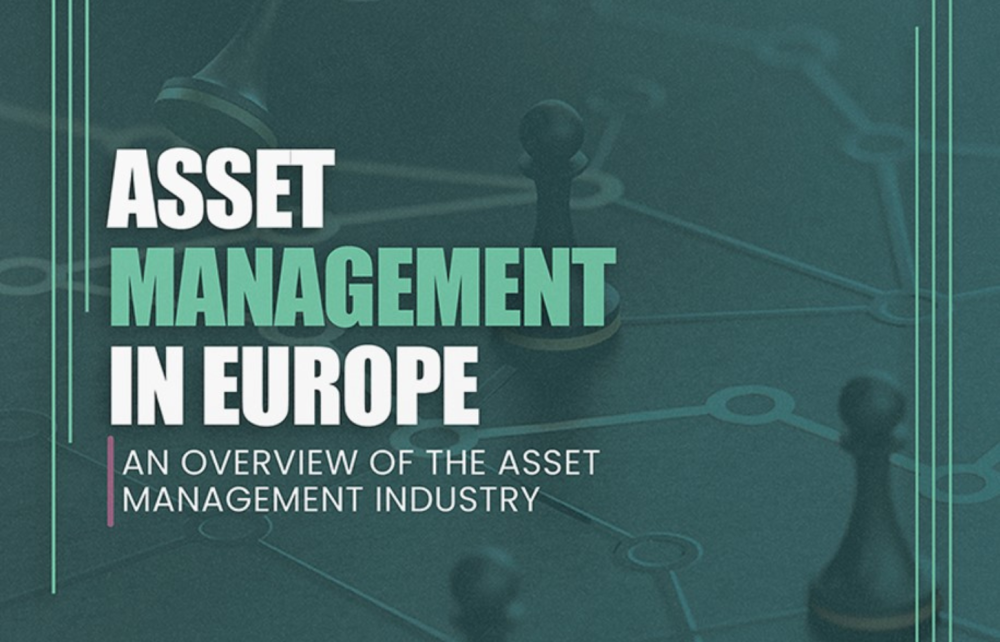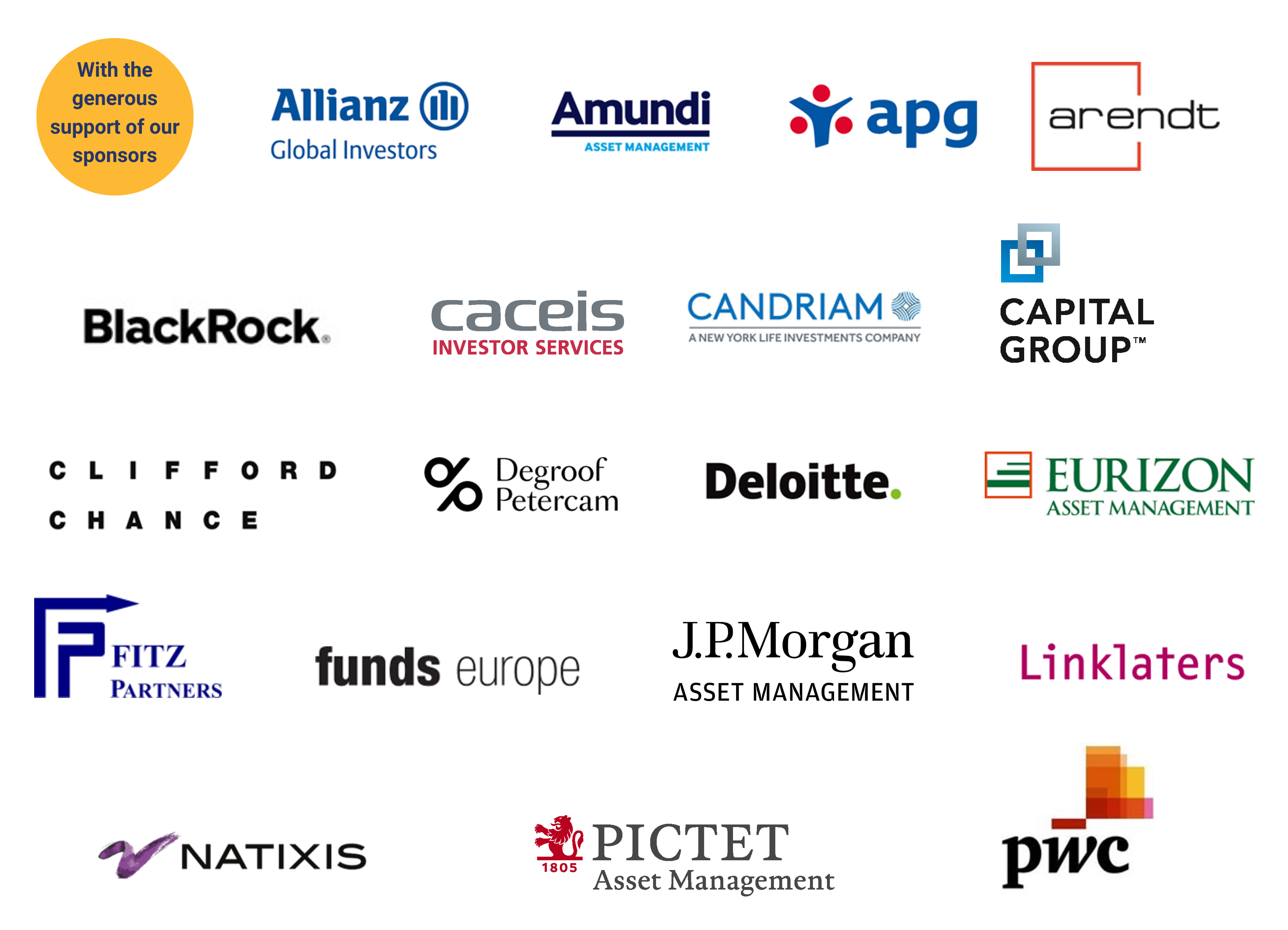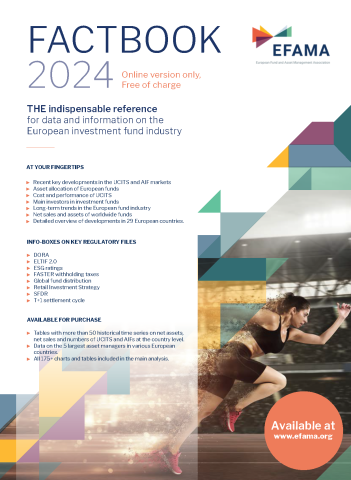EFAMA publishes its latest Monthly Statistical Release for July 2024.
With European government no longer able to provide financial security to support citizens in later years, saving for retirement is key. Individuals need to save enough for retirement to ensure adequate income in old age.
EFAMA helps by raising awareness of the importance of saving for retirement and encouraging European authorities to further modernise relevant EU legislation. This includes strengthening competition in the occupational and personal pension markets, and fostering cross-border activities of pension providers and asset managers. Such legislation should seek to create economies of scale, to benefit savers.
EFAMA is a co-initiator of the European Retirement Week.

EFAMA has published a new Investor Education brochure, titled “Invest Early, Achieve Big – Five questions on investing to build wealth over time”.
Two leading experts in the field of investor education - Professor Luigi Guiso and Anne Lester - provide insightful answers to five fundamental questions about investing.
In addition, five European citizens from diverse backgrounds, age groups, and careers share their personal experiences and approaches to investing in practice.

EFAMA's 16th edition of its ‘Asset Management in Europe’ report provides an in-depth analysis of recent trends in the European asset management industry. It highlights the growth of retail and passive investing, and how asset managers finance the European economy. In addition to data on assets under management in investment funds and discretionary mandates, industry clients, asset allocation and industry organisation, this report addresses key industry questions, including:

EFAMA’s publication lays out the asset management sector’s policy priorities for the next five years, building on the in-depth expertise of our members. This includes practical recommendations for keeping Europe competitive and developing deeper, more integrated and liquid capital markets in Europe.

Despite the growing interest and importance of sustainable investing, most EU citizens often find it difficult to navigate this relatively new investment landscape.
EFAMA has published a brochure in which we explore what sustainable investing is; what investment strategies are available; what impact you can have as on investor; what questions you should be asking your self and your financial advisor; and how to get started.

Financial literacy is essential for making sound decisions when managing savings. If European citizens do not understand financial concepts such as risk diversification, compound interest and real rate of return, they won’t know where to start or what to ask should they wish to invest their savings. A lack of sufficient financial literacy in most European countries helps explain why the vast majority of households don’t directly invest any of their savings in the capital markets.
EFAMA's Investor Education Platform has now produced an animated brochure titled ‘Investing for a better future – 5 tips to do more with your savings’ to help get people started with investing. It has been translated into several European languages.

With European government no longer able to provide financial security to support citizens in later years, saving for retirement is key. Individuals need to save enough for retirement to ensure adequate income in old age.
EFAMA helps by raising awareness of the importance of saving for retirement and encouraging European authorities to further modernise relevant EU legislation. This includes strengthening competition in the occupational and personal pension markets, and fostering cross-border activities of pension providers and asset managers. Such legislation should seek to create economies of scale, to benefit savers.
EFAMA is a co-initiator of the European Retirement Week.

EFAMA has published a new Investor Education brochure, titled “Invest Early, Achieve Big – Five questions on investing to build wealth over time”.
Two leading experts in the field of investor education - Professor Luigi Guiso and Anne Lester - provide insightful answers to five fundamental questions about investing.
In addition, five European citizens from diverse backgrounds, age groups, and careers share their personal experiences and approaches to investing in practice.

EFAMA's 16th edition of its ‘Asset Management in Europe’ report provides an in-depth analysis of recent trends in the European asset management industry. It highlights the growth of retail and passive investing, and how asset managers finance the European economy. In addition to data on assets under management in investment funds and discretionary mandates, industry clients, asset allocation and industry organisation, this report addresses key industry questions, including:

EFAMA’s publication lays out the asset management sector’s policy priorities for the next five years, building on the in-depth expertise of our members. This includes practical recommendations for keeping Europe competitive and developing deeper, more integrated and liquid capital markets in Europe.

Despite the growing interest and importance of sustainable investing, most EU citizens often find it difficult to navigate this relatively new investment landscape.
EFAMA has published a brochure in which we explore what sustainable investing is; what investment strategies are available; what impact you can have as on investor; what questions you should be asking your self and your financial advisor; and how to get started.

Financial literacy is essential for making sound decisions when managing savings. If European citizens do not understand financial concepts such as risk diversification, compound interest and real rate of return, they won’t know where to start or what to ask should they wish to invest their savings. A lack of sufficient financial literacy in most European countries helps explain why the vast majority of households don’t directly invest any of their savings in the capital markets.
EFAMA's Investor Education Platform has now produced an animated brochure titled ‘Investing for a better future – 5 tips to do more with your savings’ to help get people started with investing. It has been translated into several European languages.

With European government no longer able to provide financial security to support citizens in later years, saving for retirement is key. Individuals need to save enough for retirement to ensure adequate income in old age.
EFAMA helps by raising awareness of the importance of saving for retirement and encouraging European authorities to further modernise relevant EU legislation. This includes strengthening competition in the occupational and personal pension markets, and fostering cross-border activities of pension providers and asset managers. Such legislation should seek to create economies of scale, to benefit savers.
EFAMA is a co-initiator of the European Retirement Week.

EFAMA publishes its latest Monthly Statistical Release for July 2024.
Regulatory clarity required to sustain further growth
This report looks specifically at the evolving trends of the equity asset class of sustainable UCITS, whose share is the highest (53%) in total sustainable UCITS funds. It highlights their role as investment vehicles in facilitating the green transition. The universe of sustainable equity UCITS funds is defined based on Morningstar’s classification of sustainable financial instruments1. This means funds must claim to have a sustainability objective, and/or use binding ESG criteria for their investment selection.
EFAMA has released a joint statement together with AFME (Association for Financial Markets in Europe), EFSA and the Nordic Securities Association on significant issues with the supervision of market data costs.

Clarification is urgently needed to enable rather than restrict EU sustainable investment
The EU has been at the forefront of green bond issuances, demonstrating strong growth and commitment to sustainable finance. However, ESMA’s new Fund Naming Guidelines create inconsistencies with other sustainable finance regulations, like the EU Green Bond Standard, which could hamper the growth of the corporate green bond sector.
The Associations fully support ESMA’s aim of providing for an adequate level of transparency. This will be beneficial to investors, liquidity providers, other intermediaries, as well as issuers, across the entire range of different and diverse bond classes.
EFAMA publishes its latest Monthly Statistical Release for July 2024.
Regulatory clarity required to sustain further growth
This report looks specifically at the evolving trends of the equity asset class of sustainable UCITS, whose share is the highest (53%) in total sustainable UCITS funds. It highlights their role as investment vehicles in facilitating the green transition. The universe of sustainable equity UCITS funds is defined based on Morningstar’s classification of sustainable financial instruments1. This means funds must claim to have a sustainability objective, and/or use binding ESG criteria for their investment selection.
EFAMA has released a joint statement together with AFME (Association for Financial Markets in Europe), EFSA and the Nordic Securities Association on significant issues with the supervision of market data costs.

Clarification is urgently needed to enable rather than restrict EU sustainable investment
The EU has been at the forefront of green bond issuances, demonstrating strong growth and commitment to sustainable finance. However, ESMA’s new Fund Naming Guidelines create inconsistencies with other sustainable finance regulations, like the EU Green Bond Standard, which could hamper the growth of the corporate green bond sector.
The Associations fully support ESMA’s aim of providing for an adequate level of transparency. This will be beneficial to investors, liquidity providers, other intermediaries, as well as issuers, across the entire range of different and diverse bond classes.
EFAMA publishes its latest Monthly Statistical Release for July 2024.
Regulatory clarity required to sustain further growth
This report looks specifically at the evolving trends of the equity asset class of sustainable UCITS, whose share is the highest (53%) in total sustainable UCITS funds. It highlights their role as investment vehicles in facilitating the green transition. The universe of sustainable equity UCITS funds is defined based on Morningstar’s classification of sustainable financial instruments1. This means funds must claim to have a sustainability objective, and/or use binding ESG criteria for their investment selection.
EFAMA replied to IASB’s request for information on the Post-Implementation Review (PIR) of IFRS 9 – Classification and measurement. Our paper recaps EFAMA’s key concerns and recommendations to the IASB. The key concerns of the industry are the removal of recycling (in particular for institutional investors) and the classification of investment entities and investment funds as debt instruments.
We commend the work that IOSCO has undertaken to date on this topic including the survey work and the summary findings in the form of the report currently under review. It is fair to say that the conclusions of the report and areas for further work gave rise to detailed discussions within our industry, yielding ultimately firm views on the priority areas that we support and see value in, and areas we felt were not reflected in the study and thereby building risk into margining models in future crisis scenarios. These areas are fur
For asset managers the main issue continues to be the reclassification of ETDs as OTCs as a result of the non-equivalence of UK regulated markets. While we understand that a review is legally mandated at this point in time, we do not see value in recalibrating the various thresholds or making changes to the calculation methodologies unless these are in the two areas we define below. Our main concern revolves around the fact that changes would carry significant compliance costs while making little impact on the population of counterparties and notional captured by the thresholds.
EFAMA welcomes the decision of the European Commission to adopt a targeted approach in its review of the Alternative Investment Fund Management Directive (AIFMD), along with key harmonising provisions within the Undertakings for Collective Investment in Transferrable Securities Directive (UCITSD). This focus on targeted improvements recognises the role this framework has played in encouraging the growth in the European Alternative Investment Fund (AIF) market over the past decade and its resilience even throughout recent market stresses.
EFAMA strongly supports the Commission's draft proposal amending the ELTIF Regulation where it addresses some of the major obstacles that have undermined the attractiveness of the ELTIF product since inception. The revised legal framework has the potential to transform ELTIF into a product of choice for a larger (retail) investor audience, all while serving the purposes of the Capital Markets Union (CMU). However, some important adjustments remain to be made for the ELTIF regime to reach its full potential as a competitive long-term investment option.
The European Commission’s proposal on MiFIR establishes the blueprint for a consolidated tape (CT) for Europe’s capital markets. It also significantly alters the competitive market structure brought about by MiFID II by introducing greater transparency requirements. Finally, it addresses important issues around market data costs.
EFAMA replied to IASB’s request for information on the Post-Implementation Review (PIR) of IFRS 9 – Classification and measurement. Our paper recaps EFAMA’s key concerns and recommendations to the IASB. The key concerns of the industry are the removal of recycling (in particular for institutional investors) and the classification of investment entities and investment funds as debt instruments.
We commend the work that IOSCO has undertaken to date on this topic including the survey work and the summary findings in the form of the report currently under review. It is fair to say that the conclusions of the report and areas for further work gave rise to detailed discussions within our industry, yielding ultimately firm views on the priority areas that we support and see value in, and areas we felt were not reflected in the study and thereby building risk into margining models in future crisis scenarios. These areas are fur
For asset managers the main issue continues to be the reclassification of ETDs as OTCs as a result of the non-equivalence of UK regulated markets. While we understand that a review is legally mandated at this point in time, we do not see value in recalibrating the various thresholds or making changes to the calculation methodologies unless these are in the two areas we define below. Our main concern revolves around the fact that changes would carry significant compliance costs while making little impact on the population of counterparties and notional captured by the thresholds.
EFAMA welcomes the decision of the European Commission to adopt a targeted approach in its review of the Alternative Investment Fund Management Directive (AIFMD), along with key harmonising provisions within the Undertakings for Collective Investment in Transferrable Securities Directive (UCITSD). This focus on targeted improvements recognises the role this framework has played in encouraging the growth in the European Alternative Investment Fund (AIF) market over the past decade and its resilience even throughout recent market stresses.
EFAMA strongly supports the Commission's draft proposal amending the ELTIF Regulation where it addresses some of the major obstacles that have undermined the attractiveness of the ELTIF product since inception. The revised legal framework has the potential to transform ELTIF into a product of choice for a larger (retail) investor audience, all while serving the purposes of the Capital Markets Union (CMU). However, some important adjustments remain to be made for the ELTIF regime to reach its full potential as a competitive long-term investment option.
The European Commission’s proposal on MiFIR establishes the blueprint for a consolidated tape (CT) for Europe’s capital markets. It also significantly alters the competitive market structure brought about by MiFID II by introducing greater transparency requirements. Finally, it addresses important issues around market data costs.
EFAMA replied to IASB’s request for information on the Post-Implementation Review (PIR) of IFRS 9 – Classification and measurement. Our paper recaps EFAMA’s key concerns and recommendations to the IASB. The key concerns of the industry are the removal of recycling (in particular for institutional investors) and the classification of investment entities and investment funds as debt instruments.
We commend the work that IOSCO has undertaken to date on this topic including the survey work and the summary findings in the form of the report currently under review. It is fair to say that the conclusions of the report and areas for further work gave rise to detailed discussions within our industry, yielding ultimately firm views on the priority areas that we support and see value in, and areas we felt were not reflected in the study and thereby building risk into margining models in future crisis scenarios. These areas are fur
For asset managers the main issue continues to be the reclassification of ETDs as OTCs as a result of the non-equivalence of UK regulated markets. While we understand that a review is legally mandated at this point in time, we do not see value in recalibrating the various thresholds or making changes to the calculation methodologies unless these are in the two areas we define below. Our main concern revolves around the fact that changes would carry significant compliance costs while making little impact on the population of counterparties and notional captured by the thresholds.


Discover the 6 reasons why your organisation should become a member of EFAMA.
Our members enjoy significant benefits including the opportunity to shape the industry positions, get first-hand access to regulatory and political intelligence, engage with industry peers and policymakers, and take part in EFAMA events.
Our three membership categories cater to the wide range of organisations that make up and support the investment management industry in Europe.
